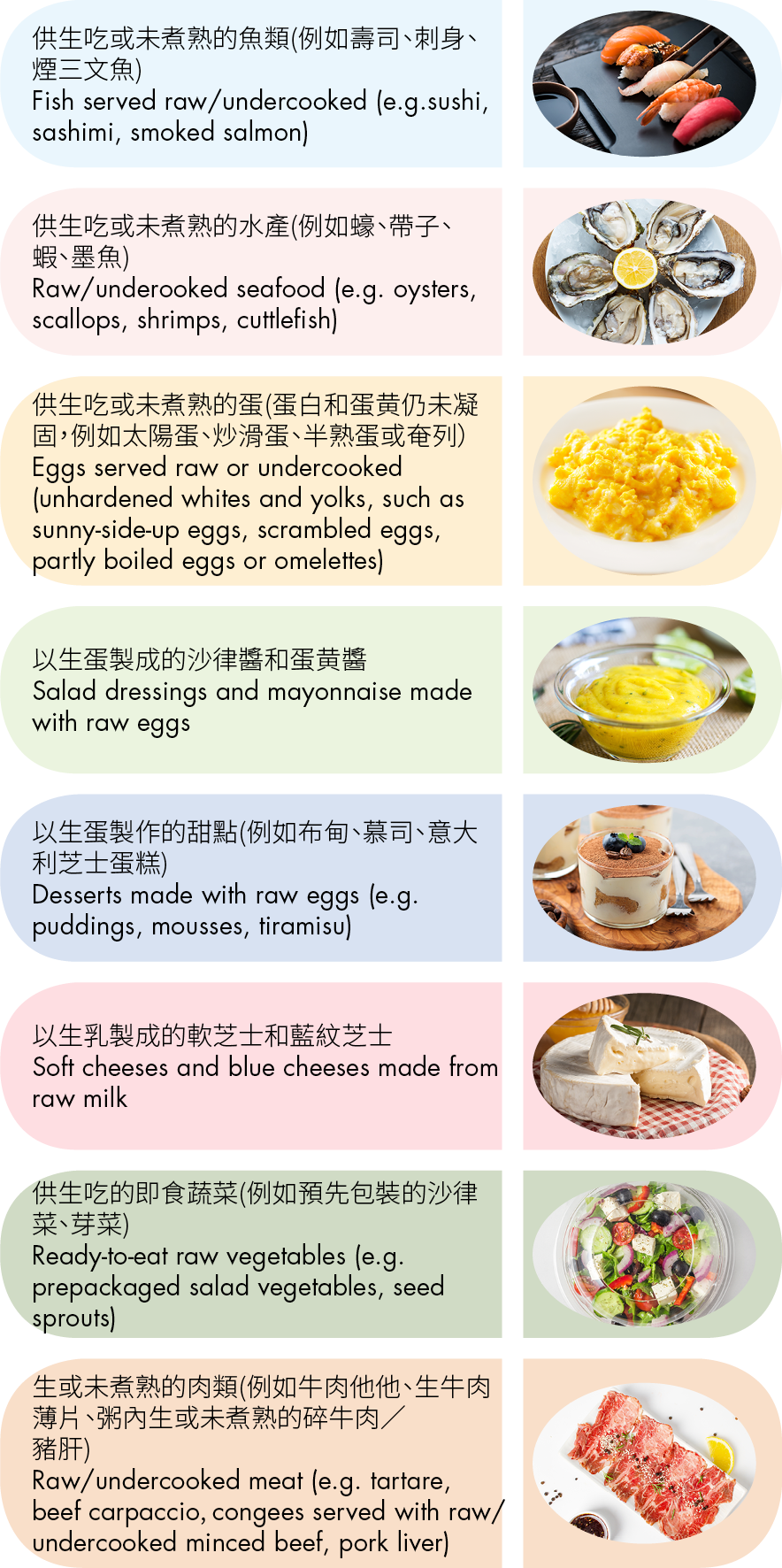
Food Safety Focus (163rd Issue, February 2020) – Food Safety Platform
Consumer Advice on High-risk Foods on Menus
Reported by Ms. Melva CHEN, Scientific Officer,
Risk Communication Section, Centre for Food Safety

Examples of some common raw/undercooked foods
What comes to your mind when hearing the term "raw/undercooked foods"? Sushi? Sashimi? Or raw oysters? How about other foods containing raw ingredients, e.g. mango puddings with raw eggs, sandwiches with smoked salmon and congees with undercooked beef? When dining out, consumers are often not aware that those seemingly harmless foods could pose serious health impact. Both consumers and food businesses should pay special attention to raw/undercooked foods.
Risk of Consumption of Raw/Undercooked Foods
Raw/undercooked foods such as meat, poultry, seafood and eggs, are high-risk foods, as there is no or inadequate heat treatment to eliminate the microorganisms present that can cause illnesses. Common symptoms of illnesses caused by eating food contaminated by bacteria or viruses include vomiting, diarrhoea, abdominal pain and fever. As for parasites, some can cause mild to moderate gastrointestinal symptoms. No matter which type of pathogens is involved, susceptible populations including pregnant women, infants, young children, the elderly and people with weakened immunity are more likely to develop severe symptoms and even face the risk of death.
Raw/Undercooked Foods are More Likely to Habour "Superbugs"
Foods can be contaminated by microorganism including "superbugs" at any stage from farm to table. "Superbugs”is a term generally used to describe microorganisms (e.g. bacteria) that have developed antimicrobial resistance (AMR), an ability to stop a wide range of antimicrobial agents, antibiotics for example, from working against them. Whether or not “superbugs”can cause illnesses, they may transfer their antibiotic resistance genes to other bacteria inside the human ody, and this in turn may affect the effectiveness of future use of antibiotics when needed. AMR is a serious public health threat. From the food safety point of view to combat AMR, cooking is an effective way to kill“superbugs".
What Can Local Food Businesses Do to Help Consumers Reduce the Risk?
In the United States, the Food and Drug Administration's Food Code requires all restaurants that sell raw/undercooked animal products to post a raw food advisory for customers. This consumer advisory is often seen as a written statement at the bottom of a restaurant menu.
While it is understandable that restaurants may choose to accede to consumer's desire for raw/undercooked food, a recent focus group meeting conducted by the Centre for Food Safety (CFS) found that local consumers are often not aware that the foods they order are raw/undercooked and they have difficulty in determining whether the dish contains raw/undercooked ingredients such as raw eggs. In this regard, the CFS has issued a set of trade guidelines aiming to facilitate food businesses in informing consumers of the increase risk of consuming raw/undercooked foods and ingredients in ready-to-eat foods served to them. Consumers can be informed by brochures, advisories on signs or menus, table tents, labelling or other effective written means. The following is an example of consumer advice that restaurants can provide, and it applies to raw/undercooked high-risk foods.
Consuming raw or undercooked foods may increase the risk of foodborne illness, especially for pregnant women, infants, young children, the elderly and people with weakened immunity.
Both Consumers and Food Businesses Share the Responsibilities to Ensure Food Safety
Restaurant owners bear the liability to provide truthful labelling to help consumers in making informed food choices. By doing so, on the one hand, restaurant owners not only help protecting consumers, especially susceptible populations, from foodborne illneseses, but also promoting the image as a responsible food trader. On the other hand, consumers have to consider their own health conditions in choosing food.


